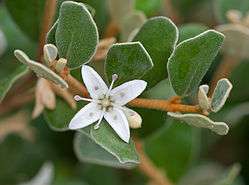Correa alba
Correa alba, commonly known as white correa, is a shrub endemic to Australia. It grows to 1.5 metres in height, has reddish-brown hairy new growth. The leaves are near circular to ovate and have a round or cuneate base and a rounded tip. They are 1.5 to 3.5 cm long 1 to 2.7 cm wide with a hairless or (nearly hairless) upper surface and tomentose lower surface. The white or occasionally light pink four-petalled flowers usually appear between mid autumn and early winter (April to June in Australia).[1]
| White correa | |
|---|---|
 | |
| Scientific classification | |
| Kingdom: | Plantae |
| Clade: | Tracheophytes |
| Clade: | Angiosperms |
| Clade: | Eudicots |
| Clade: | Rosids |
| Order: | Sapindales |
| Family: | Rutaceae |
| Genus: | Correa |
| Species: | C. alba |
| Binomial name | |
| Correa alba | |
| Synonyms | |
| |
The species was first formally described by Henry Charles Andrews in 1798.[2] There are currently two recognised varieties:
- Correa alba Andrews var. alba
- Correa alba var. pannosa Paul G.Wilson - Velvet White Correa.[3] Occurs on the south-west coast of Victoria and in the region near Encounter Bay in South Australia.[4]
Distribution and habitat
The species occurs on low-nutrient soils,[5] in sandy or rocky areas in coastal areas of south-eastern Australia south of Port Stephens,[1] particularly headlands and coastal heathlands. It can grow in areas where it is sprayed with salt water.[5] It is commonly associated with such heathland plants as coastal rosemary (Westringia fruticosa), bracelet honey myrtle (Melaleuca armillaris) and common aotus (Aotus ericoides), and dune plants such as Sydney golden wattle (Acacia longifolia).[5]
Ecology
Wombats have been known to eat the leaves and roots.[5]
Cultivation
Correa alba is a hardy species in well-drained situations that withstands coastal exposure. A position in full sun is best for flowering, but it can also be grown in part shade. It may be used to create an informal hedge or as a container plant.[6]
The 1889 book 'The Useful Native Plants of Australia records that common names included " Cape Barren Tea" in Tasmania, and that "The leaves of this plant have been used by the sealers on the islands in Bass's Straits as a substitute for tea."[7]
References
- "Correa alaba". PlantNET - New South Wales Flora Online. Royal Botanic Gardens & Domain Trust, Sydney Australia. Retrieved 25 March 2012.
- "Correa alba". Australian Plant Name Index (APNI), IBIS database. Centre for Plant Biodiversity Research, Australian Government, Canberra. Retrieved 25 March 2012.
- Wild Plants of Victoria (database). Viridans Biological Databases & Department of Sustainability and Environment. 2009.
- Wilson, Paul G. (1961). "A taxonomic revision of the genus Correa" (PDF). Transactions of the Royal Society of South Australia. 85: 40–42.
- Benson, Doug; McDougall, Lyn (2001). "Ecology of Sydney plant species Part 8 Dicotyledon families Rutaceae to Zygophyllaceae" (PDF). Cunninghamia. 7 (2): 241–462 [271]. Archived from the original (PDF) on 2017-03-16. Retrieved 2016-12-22.
- Greig, D. (1987). The Australian Gardener's Wildflower Catalogue. Australia: Angus & Robertson. ISBN 0207154600.
- J. H. Maiden (1889). The useful native plants of Australia : Including Tasmania. Turner and Henderson, Sydney.
| Wikimedia Commons has media related to Correa alba. |